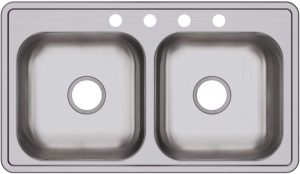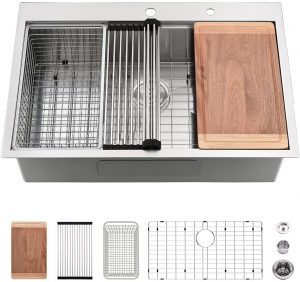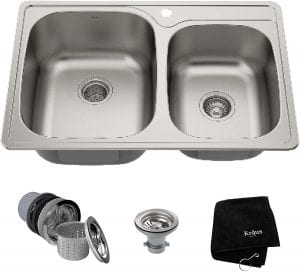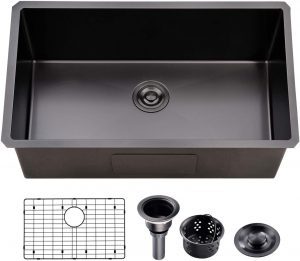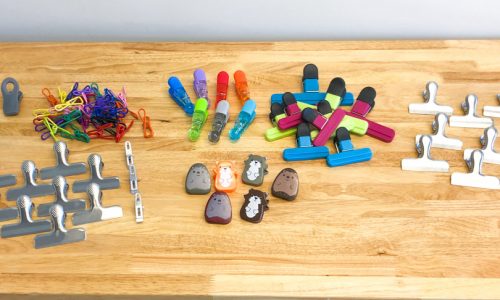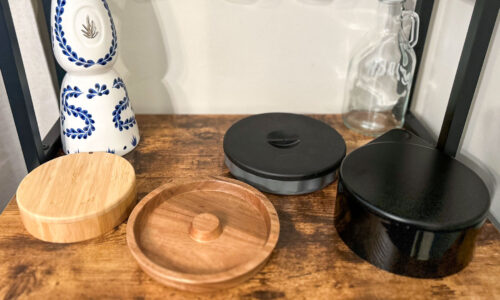The Best Kitchen Sink
We looked at the top 15 Kitchen Sinks and dug through the reviews from 83 of the most popular review sites including and more. The result is a ranking of the best Kitchen Sinks.

Our Review Process
Don't Waste Your Money is focused on helping you make the best purchasing decision. Our team of experts spends hundreds of hours analyzing, testing, and researching products so you don't have to. Learn more.
Our Picks For The Top Kitchen Sinks
- 1. Elkay U-Channel Ada Compliant Kitchen Sink, 33-Inch
- 2. Gaomasck Rounded Corner Scratch-Resistant Kitchen Sink, 30-Inch
- 3. Kraus Single Bowl Stainless Steel Kitchen Sink, 30-Inch
- 4. VASOYO Indestructible Farmhouse Kitchen Sink, 33-Inch
- 5. Bokaiya Modern Ultra Quiet Kitchen Sink, 33-Inch
- 6. ZUHNE Single Bowl Curved Front Stainless Steel Kitchen Sink, 24-Inch
- 7. MENSARJOR Handcrafted Unbreakable Kitchen Sink, 32-Inch
- 8. Kraus KTM32 Topmount Double Bowl Kitchen Sink, 33-Inch
- 9. Ruvati Single-Tier Track Cutting Board Kitchen Sink, 32-Inch
- 10. Ruvati RVH7400 Commercial Grade Kitchen Sink, 32-Inch
- 11. Zuhne Single Bowl Rust-Proof Kitchen Sink, 28-Inch
- 12. Lordear Contemporary Sloped Bottom Kitchen Sink, 32-Inch
- 13. Kraus Easy Clean Non-Toxic Kitchen Sink, 32-Inch
- 14. Kraus Porcelain Soundproof Kitchen Sink, 31.5-Inch
- 15. Ufaucet Titanium Garbage Disposable Compatible Kitchen Sink, 32-Inch
This drop-in kitchen sink is constructed using a durable stainless steel that won't stain or rust. Since the material also has a gauge of 23, it's resistant to dents as well. The double bowls allow for washing on one side and rinsing on the other.
Budget-Friendly PickYou'll love the economical price tag on this affordable kitchen sink.
If you're searching for a kitchen sink with one bowl that is nice and deep, this model is your best bet. It's made using a 16-gauge stainless steel and features rounded corners that won't collect waste. An added feature is the x-diversion line, which aids the sink in draining after each use.
Nice and DeepThis kitchen sink comes in a choice of sizes, including 10, 22 and 30 inches.
This stainless steel kitchen sink is the ideal sink for the 30-inch size. The 10-inch depth makes it have a great volume that keeps water from splashing onto the counter as you use it and the added drainage rack is great for keeping things off the bottom as they dry.
Great FeaturesThis kitchen sink is a deep 30-inch sink with added drainage rack that sits on bottom
Home chefs will absolutely fall in love with this kitchen sink. Not only does it have a deep base, but it also comes with a host of accessories that make food prep much easier. There's a built-in track for sliding in the cutting board to chop vegetables or sliding in the wire basket to wash your fruits.
Makes Food Prep a BreezeThis kitchen sink is constructed using 16-gauge T304 stainless steel, so durability isn't an issue.
Buying Guide
A kitchen sink is a focal point of many kitchens where cooking and food prep is done. Whether you are planning on updating the look and finish of your kitchen with stainless steel appliances and a matching sink, or simply looking for a stylish sink in a new kitchen, you will be faced with looking at some of the key features that kitchen sinks offer and why they might sway your decision on which model is right for you.
MORE: The Best Single-Lever Faucets
Kitchen sinks will be filled with dirty dishes or food scraps that need to be washed or disposed of through a garbage disposal. All this grime is mostly organic matter that builds up over time to produce a foul film on the bottom of your sink. This means you will want to be able to clean your sink easily, which is a task that should not be ignored in most kitchens. The good news is there are a couple of features that can enhance the ability for you to clean your sink and many manufacturers have already figured this out for you.
First, you will want to look at the geometry of the sink basin. If the bottom corners of the basin are hard lines with right angles, the act of trying to clean the sink will be challenging and frustrating. Look at styles that offer rounded corners which will make cleaning the bottom of the basin a much easier task. This will make cleaning your sink less daunting and help you keep on top of it more often.
The second aspect that makes a sink easy-to-clean is the material it is made from. It’s common to see stainless steel sinks these days in personal kitchens and their ability to be cleaned is one of the big reasons. Stainless steel is naturally antimicrobial and can be cleaned with little effort so you can spend your time on the more enjoyable aspects of using your kitchen. An alternative material that is still relatively easy to clean is an enameled steel or iron sink which offers a high-gloss surface that won’t encourage food to stick to it.
Our resident kitchen expert, Julie Chernoff, the dining editor of Better, a lifestyle website and print magazine, weighed in on the differences between these two popular styles of sinks:
“The majority of sinks are made of stainless steel, and for good reason. They are easy to clean, and won’t stain or chip. Enamel-on-metal sinks (either cast iron or steel), while available in a slew of colors — which makes them an attractive option if you are looking to match your décor — are easy to clean, but the surface can chip, scratch, or even crack if something sharp or heavy is inadvertently dropped inside.”
You’ll also want to consider the durability of each sink. It is not uncommon for a kitchen sink to stay in a kitchen for decades while seeing daily use and abuse. Sinks made of enamel-coated metals are beautiful to the eye and easy to wash, but they need to be treated gently as they can chip or crack when a heavy object like a frying pan is dropped into it carelessly. Enamel coatings are very hard and therefore more brittle than what you would find in stainless steel and this allows them to be chipped or cracked with use. An even harder material in a sink, like a granite sink, can be damaging to delicate glassware at times.
“The number of glasses that were chipped or broken in the granite sink was not trivial, and we were also constantly dealing with water stains, so I wouldn’t do that again, although it looked gorgeous,” she said.
The combination of the naturally porous granite that allows it to stain and a propensity for chipping or breaking glassware actually makes the granite sink less than ideal for general kitchen use. The remaining material, then, is stainless steel. Stainless steel will last for a very long time with minimal care and maintenance, but if you want it to look brand new over the years, you will have to be sure to note that it can become scratched with use. The scratches generally are very shallow and can be minimized in appearance by using a cleaning solution that is specifically designed to restore the finish of stainless steel.
The depth of and width of the sink is the next topic to look at when making a purchase and it’s a very important factor in the usability of the sink. Sinks come in a variety of depths and sizes that satisfy the varying needs of the users. The width of the sink is often determined by the design of your kitchen counters, while the depth can be a variable that should be catered to the specific user. A sink like the Kraus KHU100-30 Kitchen Sink, 30 Inch, Stainless Steel with a depth of 10-inches is going to allow you to wash dishes without much water splashing out onto the countertops.
“The depth of your sink is an important consideration. Being tall, I have no problem with a deeper sink, and I like that it reduces splashing. My current large stainless-steel sink is 11-inches deep,” says Chernoff.
Another item to take into consideration is the noise that can be produced by a sink. This commonly overlooked aspect can make a big difference in the daily use of your kitchen sink. Due to the fact that a sink is essentially a very large metal bowl, it would make sense that loud noises would be produced as you bang around inside of it while cleaning dishes. Look for sinks that account for this with noise-reducing padding, as this will dampen loud noises. You’ll be glad to have such a quiet sink and so will everyone else within earshot.
Our Expert Consultant

Culinary Expert
Julie Chernoff is a long-time member of Les Dames d’Escoffier (past president of the Chicago Chapter, and current co-chair of the LDEI Legacy Awards Committee), the Association of Food Journalists (AFJ) and the International Association of Culinary Professionals.
Chernoff is the dining editor of Better, a lifestyle website and print magazine. Her journalism started in the test kitchens of Weight Watchers Magazine. She holds a BA in English from Yale University and is a graduate of the California Culinary Academy. She has spent the last few decades styling, photographing, teaching, developing recipes, editing, thinking and writing about food.
Why we recommend these kitchen sinks?
Products Considered
Products Analyzed
Expert Reviews Included
User Opinions Analyzed
Our experts reviewed the top 15 Kitchen Sinks and also dug through the reviews from 83 of the most popular review sites including and more. The result is a ranking of the best of the best Kitchen Sinks.
DWYM is your trusted roduct review source. Our team reviews thousands of product reviews from the trusted top experts and combines them into one easy-to-understand score. Learn more.
What to Look For
- To avoid scuffing up the bottom of a new stainless steel sink, find one that offers a draining tray that fits flush on the bottom of the sink. The tray will keep dishes of the bottom of the sink, which allows them to air dry away from the bottom surface and has the benefit of letting fewer items contact the smooth stainless steel to produce scratches.
- Additional to the drainage rack that is offered by many manufacturers, there are some sinks that come with colanders and trays that span the sink and slide back and forth for you to use when meal prepping. These are handy accessories that let you utilize more space when you need it while still having the functionality of the sink.
- Chernoff had some final advice to share for those looking at purchasing a new sink:
“Another thing to ponder: do you need a double-bowl sink? You can use one side for washing, the other for draining. Whatever size sink you choose, measure to make sure that your largest pot, pan or roasting pan can fit in it.”
- Whichever route you decide to take on your new kitchen sink, be sure to take these main factors into account and you’ll find a sink that suits you well and lasts for many years to come.
More to Explore
Sinks, in their original form as washstands, are known to have been around in some form for most of the history of man. Ancient Greek art depicts people using washbasins that resemble shallow bowls with a large diameter, similar to the design of a wok, to wash their hands or other items in. During this same time in history, there are records of mechanical draining mechanisms that worked with counterweights to fill and drain these washbasins. A lot of technology has developed since those days, but the cabinet-mounted sink has seen little more than a few makeovers in material and design.

